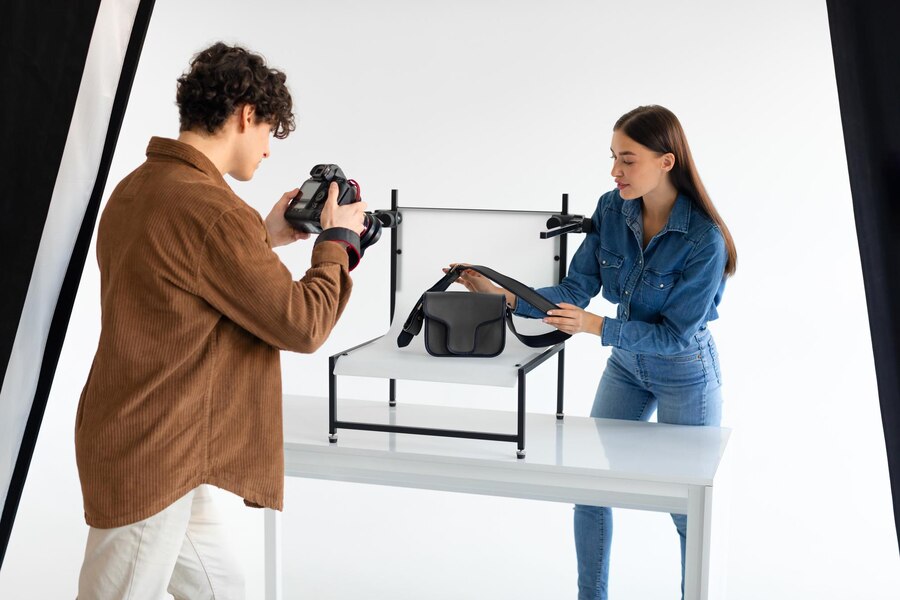How to Build Your Photography Portfolio in 2024?
For budding and emerging photographers, building a good portfolio is equivalent to creating a powerful resume. It’s the best way to show off your skills and style to attract people who might want to hire you. Before you start, figure out what type of photos you enjoy taking the most, like family pictures or headshots. This helps you make a portfolio that appeals to the people you want to work with.
Remember, it’s quality, not quantity, that matters when choosing photos for your portfolio. Pick your best pictures that are clear, well-lit, and nicely framed. Your portfolio isn’t a one-time thing – it should grow and change as you get better at photography and take on new projects. For beginners, having a standout portfolio is crucial to getting your foot in the door and getting your first photography job. So, creating a portfolio is like telling your visual story in a way that opens up exciting opportunities in the photography world.
Why is it important for Photographers to create a portfolio?
In 2024, photographers need to have a portfolio – Why? Because when people want to hire a photographer, they usually check out their online portfolio. It’s like a photo story of a photographer’s journey, showing how they’ve grown and kept up with new trends. A well-organized portfolio helps photographers market themselves better on social media and other platforms, making it easier for them to get noticed and land new opportunities in the ever-changing world of visual storytelling.
Also, a portfolio is like a highlight reel for a photographer’s skills and style. It’s a quick way for potential clients to see what kind of photos a photographer is great at capturing. This makes it easier for clients to decide if a photographer’s artistic vision matches what they’re looking for. A diverse and well-put-together portfolio not only shows that a photographer knows their technical stuff but also shares their unique perspective, helping them stand out in a busy field.
Do you want free career counseling?
Ignite Your Ambitions- Seize the Opportunity for a Free Career Counseling Session.
- 30+ Years in Education
- 250+ Faculties
- 30K+ Alumni Network
- 10th in World Ranking
- 1000+ Celebrity
- 120+ Countries Students Enrolled
Read Also: How to Use Natural Light in Photography: Step-by-Step Guide
In today’s digital world, where everything happens online, having a portfolio is just practical. When people – whether they’re clients, collaborators, or friends – want to learn more about a photographer, they’re likely to look them up on the internet. A professionally presented portfolio ensures that the photographer makes a good and lasting impression. So, a portfolio isn’t just a bunch of photos; it’s a useful tool that makes it easier for photographers to connect with opportunities and clients who appreciate their artistic vision.
Step-by-Step process to create a portfolio
1. Establish Clear Goals:
When you’re putting together your portfolio, start by figuring out what you want to achieve. Ask yourself what your goals are – do you want to attract certain types of clients, focus on specific industries, or show off a variety of your work? By deciding what you want from your portfolio, you create a plan for putting it together. Whether you want to show that you can do a bit of everything or that you’re good at one thing, having a clear idea helps make your portfolio effective and useful for your career.
2. Choose Your Best Work:
When you’re making your portfolio, pick the absolute best pictures you’ve taken. Go for the ones that show off not just how good you are with the technical stuff but also capture your unique style and artistic vision. Remember, it’s better to have a smaller collection of really awesome photos than a bunch of just okay ones. Your portfolio is like a visual story of who you are as a photographer, so each picture should add to the story and make a strong impression on the people looking at it.
Read Also: How to Become a Photojournalist [Step by Step Career Guide]
3. Make an Online Portfolio:
Create a special website just for your portfolio so that it’s easy for potential clients and collaborators to find. Use platforms that are easy to understand, so you can organize your photos well and make them look interesting. A nicely designed online portfolio not only shows off your talent in a professional way but also makes it so more people online can see and appreciate your work.
Do you want free career counseling?
Ignite Your Ambitions- Seize the Opportunity for a Free Career Counseling Session.4. Produce High-Quality Prints:
Even though the digital stuff is important, don’t forget about the power of really good prints. Spend some money on getting your best work professionally printed – it’s like having physical copies of your skill and hard work. These prints are super useful for meetings, shows, or when someone’s checking out your portfolio in person. Looking at printed photos not only sticks in people’s minds but also lets them feel and appreciate the actual quality of your photography.
5. Narrate a Story with Your Pictures:
Make your portfolio stand out by giving a story to each photo. Instead of just showing them, add short captions or descriptions that explain what’s happening in each picture. This not only gets people more interested but also shows that you can talk about the feelings and stories in your photos. Adding these bits of information turns your portfolio into more than just a bunch of pictures – it becomes a story that connects with the people looking at it, helping them understand your creative process better.
Read Also: 7 Mobile Photography Tips and Tricks for Stunning Photos
6. Keep Your Portfolio Updated:
Don’t forget to regularly update your portfolio to keep it current. When you create new stuff or get better at your craft, make sure to add it to your portfolio. Get rid of old or not-so-great photos and replace them with new ones that show how you’ve improved. A portfolio that’s always changing and staying up-to-date helps you keep up with what’s trendy in the photography world. It also shows that you’re getting better all the time, making you more appealing to people who might want to work with you.
7. Draw Inspiration from Other Photographers:
Don’t hesitate to take inspiration from other photographers’ portfolios. Explore their work, see what you like, and think about how you can apply similar ideas to your photos. It’s like getting a creative boost and learning new tricks. But remember, it’s not about copying – it’s about finding fresh ideas to make your work even better. Looking at others’ portfolios can spark your imagination and push you to try different things in your photography, making your portfolio stand out.
8. Introduce Yourself Briefly:
When putting together your portfolio, don’t forget to share a short introduction about yourself. Briefly mention who you are, what you’re passionate about in photography, and maybe a fun fact or two. It’s like giving your audience a quick peek into the person behind the camera. This personal touch adds a human element to your portfolio, making it more relatable and memorable. Clients and collaborators often appreciate knowing a bit about the artist, so consider it as your friendly handshake in the visual world.
Read Also: 3 Important Composition Rules in Photography: How to Take Better Photos
9. Showcase Your Creative Process:
Include behind-the-scenes glimpses or descriptions in your portfolio to give viewers a sneak peek into your creative process. Share a bit about how you approach your photography – whether it’s your choice of equipment, favorite techniques, or the stories behind certain shots. This provides a deeper connection between your audience and your work, offering insights into the thought and effort that goes into each photograph. Adding this personal touch can make your portfolio more engaging and foster a sense of connection with those exploring your visual journey.
10. Share Your Work on Social Media:
Don’t just update your portfolio; put your best pics on social media, like Instagram. Sharing your work there not only lets more people see it but also shows how your skills are getting better. Social media is a cool place to connect with a big group of folks, get quick feedback, and stay in the loop with what’s hot in photography. Consistent sharing on platforms like Instagram enhances your online presence, making you more discoverable and appealing to potential clients and collaborators.
11. Cultivate a Network:
Realize how important it is to connect with people in the photography community. Go to photography events, join online chats, and actively look for chances to work together. Making friends in the field doesn’t just open doors to extraordinary projects and potential clients; it also gives you a place to get helpful feedback and learn new things. Having good connections can lead to getting recommended for jobs, teaming up on projects, and getting more people to see your portfolio. Building a network boosts your journey in photography, helping you grow both personally and professionally in this exciting field.
Conclusion
For photographers, having a strong online presence with a well-kept portfolio isn’t just helpful – it’s super important. It helps you connect with people who like your work, advertise what you offer, and build up your brand. Also, having a mix of different types of photos in your portfolio is a good idea. It makes you interesting to a bunch of different people and shows off all the cool stuff you can do with your camera.
Read Also: Understanding the Rule of Thirds: Composition Techniques for Stunning Visuals
So, as you keep going on your photography adventure, remember that your online portfolio is more than just a bunch of pictures – it’s like a living record of how you’re growing and getting better at what you love. And hey, if you’re keen to learn more about photography, consider checking out the AAFT School of Photography. We’ve got some great courses to help you level up your photography skills!
Faq
How can social media, especially platforms like Instagram, contribute to a photographer’s portfolio?
Posting photos on social media platforms like Instagram broadens the photographer’s audience, shows ongoing improvement, and makes them more attractive to potential clients and collaborators.
Why is seeking feedback important for photographers creating a portfolio?
Constructive feedback from peers, mentors, and the target audience refines a photographer’s work and improves their ability to engage potential clients.
How does a portfolio act as a dynamic representation of a photographer’s journey?
A portfolio evolves with a photographer’s growth and progress, serving as a living record of their artistic development and adaptation to new trends in the photography world.
What should photographers prioritize when selecting photos for their portfolio?
Photographers should prioritize quality over quantity when choosing images for their portfolio. Select clear, well-lit, and nicely framed photos that represent their unique style and skills.

AAFT has been providing the world with limitless creativity and expression since 1993! Through a dynamic and industry-driven curriculum, AAFT provides engaging and captivating articles to persuasive blogs and empowers its readers to explore diverse avenues of creative media education-related content.







